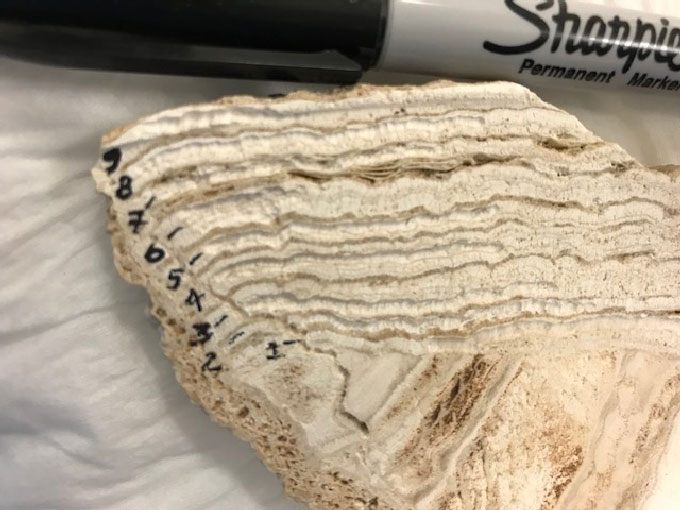Kari Finstad | 18-FS-024
Overview
Precipitation of carbonate minerals is one of the most stable methods to remove carbon dioxide (CO 2 ) from the atmosphere and sequester it within a solid crystal structure, but the process is slow relative to rates of global CO 2 production. Mineralization of atmospheric CO 2 occurs naturally during alteration of Mg-rich minerals (e.g., mining-waste piles, fractured ultramafic systems). Carbon mineralization occurs through the reaction of aqueous cations (Mg 2+ , Ca 2+ ) and dissolved bicarbonate (HCO3-). Previous studies have confirmed that actively precipitating systems incorporate modern atmospheric CO 2 by measuring F 14 C > 1. If atmospheric CO 2 is the sole carbon source, radiocarbon dating using the “bomb curve,” or rise in atmospheric 14 C content due to weapons testing, should provide the year (plus or minus a year) of carbonate precipitation. The results of our study indicate that radiocarbon dating can be used to distinguish between atmospheric and older system-recycled carbon during the precipitation of Ca and Mg carbonates in an array of different ultramafic settings. This allows the quantification of atmospheric carbon sequestered. The carbonate samples examined in this project suggest that it is not feasible to derive rates of precipitation using bomb-pulse radiocarbon dating, owing to the non-layered stratigraphy of precipitation and/or contamination with older system-recycled carbon shifting the radiocarbon dates off the bomb curve.
Background and Research Objectives
Anthropogenic emission of greenhouse gases is projected to result in a greater than 2°C warming of the earth within this century. Warming of this magnitude is expected to result in numerous adverse impacts to ecosystem stability and weather systems, which in turn threatens our national security. Recent research suggests that reductions in emissions alone will not be sufficient to limit global warming to 2°C, and that the active removal and sequestration of atmospheric carbon is required to stay below this threshold.
Precipitation of carbonate minerals is one of the most stable methods to remove CO 2 from the atmosphere. Mineral carbonation occurs passively during the alteration of Mg- and Ca-rich minerals such as silicates and hydroxides, as bicarbonate reacts with the liberated Mg 2+ and Ca 2+ . This process has been observed occurring naturally in numerous ultramafic (ferromagnesian igneous) settings, including mine-tailings piles and ophiolite formations, generating much interest in harnessing mineral carbonation for atmospheric carbon-sequestration purposes. While this process has much potential as a CO 2 sequestration strategy, it occurs slowly and it is challenging to quantify the amount of carbon taken up in the process. For mineral carbonation to be a successful sequestration strategy, a more accurate method for quantifying carbon sequestration is necessary, as well as a means to verify that the carbon is of atmospheric origin (rather than old carbon recycled through the system).
Previous radiocarbon dating of samples from mine-tailing piles and ophiolite formations have confirmed that ultramafic systems are precipitating carbon with some amount of modern atmospheric CO 2 . However, it has not been possible to quantify this. This project attempts to determine whether it is feasible to use bomb-pulse radiocarbon dating to quantify atmospheric carbon sequestration and determine rates of carbon sequestration during mineral carbonation in a diverse set of ultramafic environments. The figure below depicts an example mineral examined in the project.
The project achieved its main objectives. Our results indicate that radiocarbon dating can be used to distinguish between atmospheric and older system-recycled carbon during the precipitation of Ca and Mg carbonates in an array of different ultramafic settings, allowing sequestered atmospheric carbon to be quantified. The carbonate samples examined in this project suggest it is not feasible to derive rates of precipitation using bomb-pulse radiocarbon dating. This is due to the non-layered stratigraphy of precipitation and/or contamination with older system-recycled carbon shifting the radiocarbon dates off the bomb-curve.
Impact on Mission
This project directly supports the Lawrence Livermore National Laboratory’s mission of energy and climate security, specifically contributing to the Laboratory director’s carbon initiative. Additionally, this research strengthens the Laboratory’s core competencies of earth and atmospheric science and nuclear, chemical, and isotopic science and technology.
Conclusion
This project has laid a foundation for the Laboratory to work in the field of mineral carbonation. The team will pursue funding from the State of California to continue working on a method to account for atmospheric carbon sequestered during carbonate precipitation in different ultramafic systems. This project has strengthened collaborations between the Laboratory and researchers at multiple universities and in the mining industry. These collaborations will be essential for securing follow-on funding and obtaining access to sites and samples required to complete this work.






